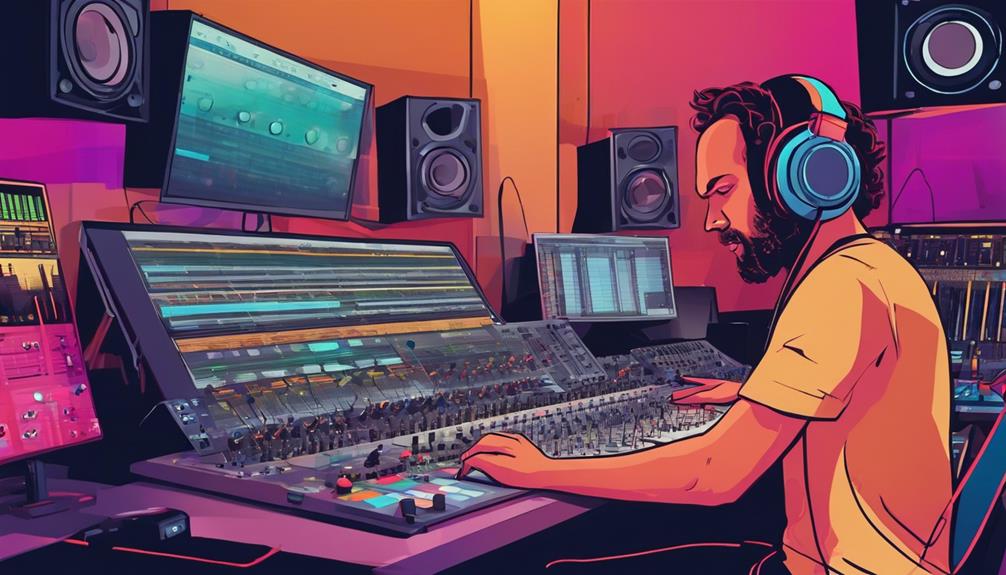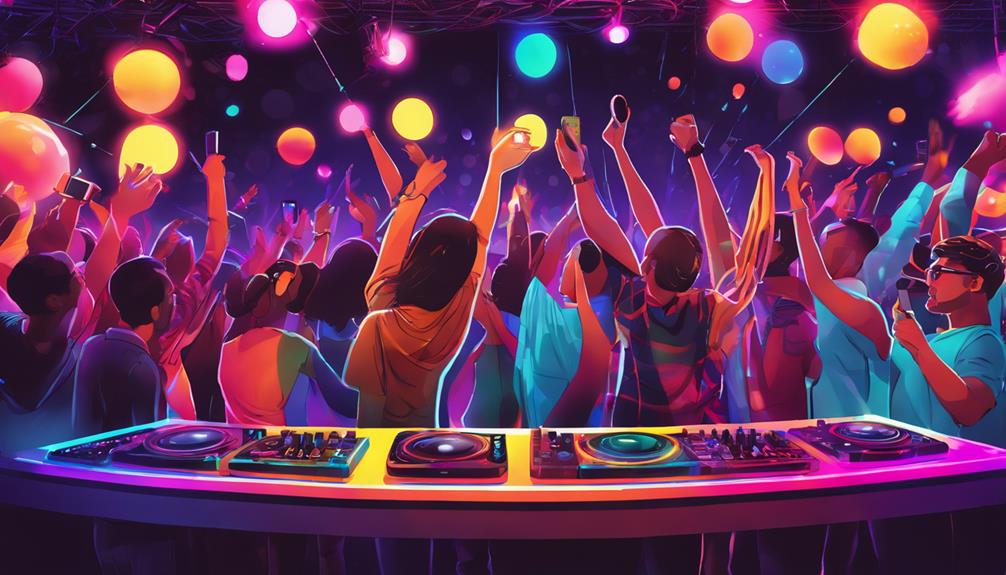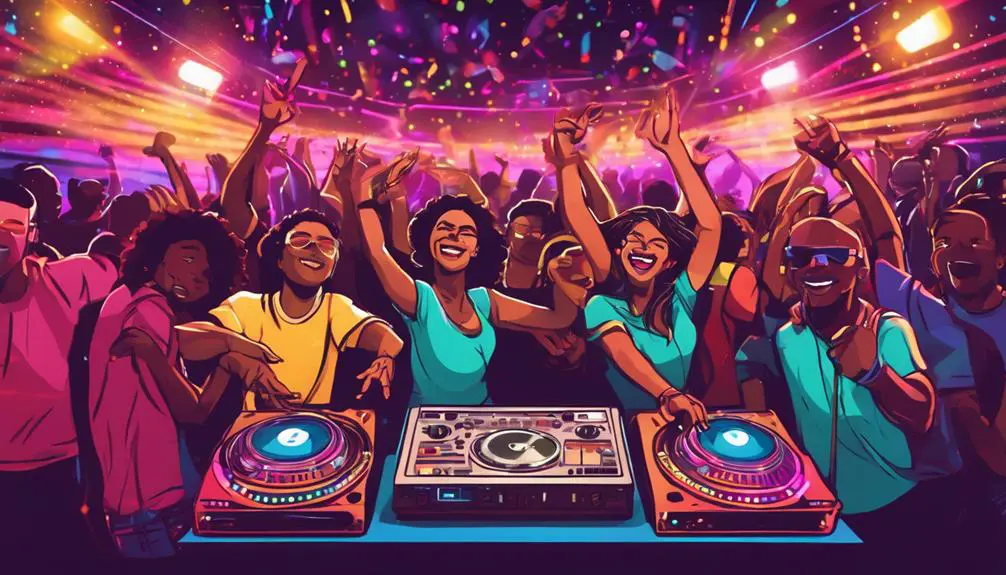No products in the cart.
To rock any party as a DJ, you need to master these seven must-have skills. First, get your beatmatching on point to sync tracks seamlessly. Next, make those changes smooth by matching beats per minute and using your EQ skills. Always read the crowd; their energy tells you what track to drop next. Delve into music theory to mix harmonically and keep the vibe flowing. Boost your stage presence; interact confidently and maintain eye contact. Be prepared to improvise, adapting to the crowd’s mood instantly. Finally, keep your passion for music alive by exploring new sounds and genres. Ready to transform your sets? Let’s get started!
Contents
hide
Key Takeaways
- Master beatmatching techniques to ensure seamless synchronization between tracks.
- Develop the ability to read and engage the crowd, adapting music to their energy.
- Utilize music theory knowledge for harmonic mixing and rhythmic structure alignment.
- Enhance stage presence through dynamic interactions and confident body language.
- Cultivate flexibility and improvisation skills to adapt to unexpected situations during performances.
Mastering Beatmatching Techniques
To rock your next DJ set, you’ll need to master beatmatching, the art of syncing the beats of two tracks seamlessly. It’s not just about mixing tunes; it’s about creating a vibe that keeps the dance floor alive. By mastering tempo synchronization and beat alignment, you guarantee that the shift between your tracks is so smooth, your crowd barely notices the switch. Imagine blending beats so perfectly that the energy never dips but only escalates.
You’ll use pitch control to tweak the speed of your tracks, making sure they align perfectly. Don’t forget the jog wheels—your best friends for making those fine adjustments that keep the beats in sync. It’s all about the seamless flow, where one track complements the next, maintaining an irresistible rhythm that captivates your audience.
Make no mistake, mastering these techniques requires practice. Dedicate time to train your ear, refining your ability to detect even the slightest off-beat mismatch. As you get better at track blending, you’ll find your sets gaining a polished, professional edge that sets you apart. Remember, in the world of DJing, beatmatching isn’t just a skill—it’s an art form. Embrace it, perfect it, and watch your DJ career soar.
Crafting Seamless Transitions
Building on your beatmatching skills, let’s explore how to seamlessly weave songs together using precise EQ and volume adjustments. Mastering the art of crafting seamless connections is not just about knowing when to switch tracks but how to blend them so smoothly that your audience barely notices. You’ve got to be slick with your BPM matching and have your EQ control dialed in perfectly.
Here’s a quick guide to help you master these essential skills:
| Technique | Description |
|---|---|
| BPM Matching | Ensure both tracks play at similar beats per minute to avoid any jarring changes. |
| EQ Control | Adjust bass, mid, and treble frequencies to blend tracks without overpowering elements. |
| Cue Timing | Practice hitting cue points precisely to make connections clean and timed perfectly. |
| Track Structure Aware | Utilize the natural breaks in tracks, like intros and outros, for smoother connections. |
Reading and Engaging the Crowd
Mastering the art of reading and engaging the crowd can enhance your DJ performances from great to unforgettable. Tuning into the audience’s reactions and body language is key to understanding their vibe and energy levels. When you see them getting hyped up, it’s your cue to keep the momentum going. Conversely, if you notice a dip in enthusiasm, that’s your signal to switch things up.
Crowd interaction isn’t just about playing music; it’s about creating an experience. Here’s how you can connect more deeply:
- Monitor Body Language: Look for signs like head nodding, foot tapping, or hands in the air. These cues can guide you in maintaining or elevating the crowd’s energy.
- Adjust Song Selection: Use audience feedback to tailor your set. If a track isn’t resonating, be bold — switch genres or tempo to recapture their interest.
- Foster Interaction: Encourage dance-offs, shout-outs, or sing-alongs to make your set a collaborative affair.
Applying Music Theory
Now, let’s enhance your sets by mastering music theory!
You’ll find that understanding harmonic mixing techniques not only boosts your flow but also keeps the crowd vibing to a consistent groove.
Plus, getting a handle on rhythmic structures guarantees your tracks are flawlessly synced, making every performance feel like a hit!
Harmonic Mixing Techniques
Harnessing harmonic mixing techniques allows you to blend tracks seamlessly, leveraging music theory to enhance your DJ performances. Immerse yourself in the world of key modulation and advanced techniques to make your mixes truly stand out. With harmonic mixing, you’re not just playing tracks, you’re crafting an audible journey.
Here are some creative strategies to master:
- Utilize Tools: Software like Mixed in Key or the Camelot Wheel helps analyze and plan your sets by key.
- Music Theory: Understand key signatures and scales to pick tracks that naturally flow together.
- Practice Blends: Match elements like kick drums and basslines to make sure your transitions are flawless.
Embrace these tips to keep your sets sounding fresh and engaging.
Rhythmic Structure Understanding
To enhance your DJ game, you’ll need to grasp the essentials of rhythmic structure. This includes tempo, time signatures, and rhythm patterns. Understanding these elements isn’t just about keeping the beat; it’s about manipulating it.
Mastering tempo variations and time signature changes can dramatically shift the energy of your set. Imagine seamlessly shifting between a sultry 3/4 waltz into a high-energy 4/4 dance track—this is where your skill shines!
Diving deeper, rhythm patterns and syncing techniques are your bread and butter. They allow you to match beats and sync tracks effortlessly, maintaining a fluid and dynamic performance. With this knowledge, you’ll not only keep the dance floor full but also captivate your audience with your impeccable, rhythmic wizardry.
Enhancing Stage Presence
Improving your stage presence is crucial for engaging and connecting with your audience during a DJ performance. By mastering stage interaction and fostering audience connection, you’re not just playing tracks—you’re creating an unforgettable experience. Let’s delve into how charisma and confidence are your best tools for mesmerizing your crowd.
- Engage with Body Language: Your movements are powerful. Use dynamic gestures and dance along to your beats. This doesn’t just show your enthusiasm for the music but also invites the audience to join in the fun.
- Make Eye Contact: Locking eyes with your audience members, even briefly, can make them feel recognized and part of the event. It’s a simple yet effective way to strengthen your connection with the crowd.
- Exude Confidence: Take the stage with assurance. Confidence is contagious and sets the tone for your performance. When you look like you own the stage, the audience believes it too.
Improvisation and Flexibility
As a DJ, you know the pulse of the party can shift in a heartbeat, and that’s where your skills in improvisation and flexibility come into play.
Whether it’s adapting to a sudden surge in energy or handling a curveball song request, your ability to smoothly shift can make or break the vibe.
Mastering these skills guarantees you’re not just playing tracks—you’re crafting an unforgettable experience for every attendee.
Adapting to Audience Energy
When you’re behind the decks, adapting to the crowd’s energy isn’t just smart; it’s essential for rocking the party! Your ability to adjust on the fly transforms a good set into an unforgettable experience. Reading the room and tweaking your playlist guarantees that every track resonates with the audience.
- Crowd Interaction: Engage with your audience, gauge their reactions, and tailor your music to amplify their energy.
- Energy Adjustment: Shift the tempo and style according to the vibe. A sudden drop or an unexpected classic can electrify the atmosphere.
- Spontaneous Creativity: Use your improvisation skills to mix tracks in ways that keep the crowd guessing and dancing.
Stay flexible, stay sharp, and watch the crowd go wild!
Handling Unexpected Situations
Moving through unexpected situations with quick thinking and flexibility not only keeps the music flowing but also highlights your prowess as a dynamic DJ. When you’re faced with a sudden change in the crowd’s vibe or a technical hiccup, your ability to improvise is key. Flexibility lets you switch up the genres or tweak your set to keep the audience engaged. It’s all about quick reactions and smart problem-solving to maintain the vibe and make sure the party never stops.
Here’s a quick guide:
| Situation | Strategy |
|---|---|
| Equipment failure | Have backup gear ready |
| Crowd energy shifts | Read the room, adjust the playlist |
| Technical issues | Stay calm, troubleshoot quickly |
| Unexpected requests | Be prepared with a varied library |
Stay adaptable, and you’ll not only solve problems but also wow your audience with your seamless skills!
Cultivating Passion for Music
To truly excel as a DJ, you must cultivate a deep-seated passion for music, exploring varied genres and mastering musical theory. Music exploration isn’t just a necessity; it’s an integral element of your artistic growth. Diving into genre immersion allows you to connect with a wider audience, understanding the nuances that make each style unique.
Here’s why nurturing your passion for music is essential:
- Music exploration: Constantly seeking out new sounds and artists keeps your sets fresh and innovative. It’s about being on the cutting edge, always adding new tracks to your repertoire.
- Genre immersion: Fully diving into different musical styles not only broadens your skill set but also deepens your appreciation for the art of music. This knowledge translates into more dynamic and engaging performances.
- Sharing your passion: When you’re genuinely excited about the music you play, it resonates with your audience, creating unforgettable experiences that they’ll want to relive.
Frequently Asked Questions
What Skills Do You Need to Be a Successful Dj?
To excel as a DJ, you’ll need exceptional beatmatching, a solid grasp of music theory, and sharp crowd-reading skills. Hone your music curation and audience engagement to truly captivate and energize your listeners!
What Are the Qualities of a Good Dj?
You’ll shine as a DJ with killer audience engagement and savvy music selection. Knowing what tracks to spin and when to pump up the crowd makes you the heart of any party!
What Makes a Talented Dj?
You’re a talented DJ if you’ve mastered equipment expertise and excel in crowd interaction. Seamlessly blending tracks and energizing the crowd, your skills transform any gig into an unforgettable musical journey!
What Makes a Perfect Dj?
To be a perfect DJ, you’ve got to master equipment and ace crowd reading. It’s all about blending beats flawlessly while keeping the vibe alive. Stay sharp, and the crowd will always want more!
Conclusion
Ready to rock the decks? Master these killer skills to make sure every set you play is unforgettable.
Get your beatmatching down to a science, switch like a pro, and keep the crowd pumped.
Dive deep into your music theory, amp up your stage presence, and stay flexible—improvise to keep things fresh.
Most importantly, let your passion for music shine through every track you spin.
Now, go out there and turn the tables on what it means to be a phenomenal DJ!




